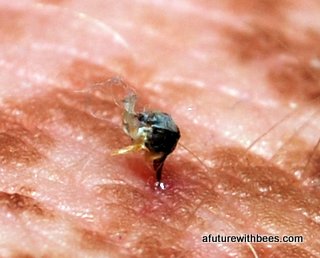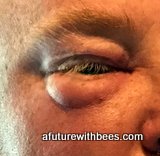Studies have found that 15% to 20% of people who are asked will say they’re allergic to bee stings, yet medical evaluations find it’s actually only about 1%.
If you are stung by a honey bee, one of the most important things to do is not to panic. Panic by the person stung or those around him/her can produce a systemic reaction in itself. Many people believethey are allergic to honey bees when in fact they are experiencing symptoms of a normal reaction. Only a very limited portion of the population (one or two out of 1000) is allergic or hypersensitive to bee or wasp stings.
The average person can safely tolerate 10 stings per pound of body weight. This means that although 500 stings could kill a child, the average adult could withstand more than 1100 stings. Most deaths caused by multiple stings have occurred in elderly individuals who may have had poor cardiopulmonary functioning.
If stung by a honey bee, the first thing you should do is remove the stinger. The end of a sting is barbed and will remain stuck in the skin even if the bee is removed. Muscles in the stinger allow it to continue pumping venom into the victim, even if it is no longer connected to the bee, for up to a minute or until the stinger is removed. The sooner the stinger is removed, the less venom will enter the wound. Honey bees are able to sting only once and eventually die after they have released their stinger.
How to remove the stinger:
Do not pull the stinger out with your fingers or tweezers because this will squeeze out more venom. Instead, scrape the stinger out with your fingernail, the edge of a credit card, a dull knife blade, or other straight edged object.
Two kinds of reactions are usually associated with bee stings and those of other stinging insects as well: (1) local or (2) systemic, allergic, or life-threatening.
(1) Local Reactions:
A local reaction is usually characterized by pain, swelling, redness, itching, and a wheal surrounding the wound made by the stinging apparatus. Swelling can sometimes be severe. For instance, if stung on the finger, the arm may be swollen even up to the elbow. Swelling such as this is fairly common, even though it may be alarming. However, a more serious allergic reaction may be indicated if swelling occurs in other parts of the body besides the general area in which the sting occured. For example, if stung on the left hand and the right hand or neck shows swelling you should seek medical attention immediately. Normal swelling may last up to a few days. During the days following a stinging incident, the wound may itch.
This is the reaction of a majority of persons and those suffering it are considered to be at little risk of death, unless the mouth or throat is affected so that the respiratory tract is obstructed. Many in the general population continue to believe that because they "swell up," they are at risk of losing their life when stung by bees.
How to alleviate the sting: Swelling may be reduced by icing the wound and/or taking an antihistamine such as Benedril. Topical solutions such as calamine may also help to alleviate pain associated with stinging. It is beneficial to drink plenty of water. We keep a bucket of slightly soapy water (dawn dish soap) to clean the wound, remove pheromones and it helps breakdown the proteins that cause the pain. Another great Treatment is meat tenderizer.
(2) Systemic, Allergic, or Life-Threatening Reactions:
It is possible to have a severe allergic reaction to a bee sting that is not life-threating. Remember, if an allergic reaction occurs, do seek medical attention immediately, but don't panic. Panic will only worsen the reaction. Allergic reactions to bee stings can develop anywhere on the body and may include:
- Rash or hives
- Stomach cramps, nausea, vomiting, or diarrhea
- Dizziness or severe headache
- Swelling that is not in the general area of the sting site, especially in the throat, neck, or tongue.
- Shortness of breath or difficulty in swallowing.
- Shock
- Unconsciousness
- Drop in blood pressure
If you experience any of these symptoms, seek emergency medical assistance immediately. Symptoms can begin immediately following the sting or up to 30 minutes later and might last for hours. Anaphylaxis, or the inability to breathe, may occur within seconds or minutes of a sting.
Anaphylaxis, if treated in time, usually can be reversed by epinephrine (adrenaline) injected into the body. Individuals who are aware that they are allergic to stings should carry epinephrine in either a normal syringe (sting kit) or an auto-injector (Epi-Pen) whenever they think they might encounter stinging insects. Epinephrine is obtainable only by prescription from a physician.
Thanks for content help from USDA.gov

